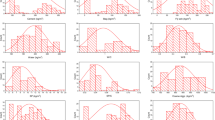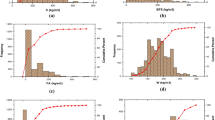Abstract
For decades, concrete has been one of the most used materials in the construction industry around the world. Concrete consists of various materials of which cement is an essential component, majorly contributing in better bonding between aggregates and contributes in strength. But when it comes to sustainability, this material has contributed about 8% of the total world \({CO}_{2}\) emission while manufactured. Proportions of various chemical and mineral admixtures, plasticizers, and fibers were analyzed to achieve high strength, satisfactory durability, and sustainable concrete. Various machine learning (ML) techniques were used for carrying out these tasks. Because of the absence of any empirical relation between the compressive strength of concrete and the new and upcoming concrete mixtures, machine learning techniques have been put to use for the predictions of various mechanical properties of concrete. Numerous ML algorithms right from basic linear regressions to individual support vector regressions (SVR) to ensemble methods like bagging and boosting have been used for which appropriate train-test split is employed for reducing overfitting. We aim to reduce the dearth of knowledge pertaining to this specific domain by our comprehensive research. A number of different ML models are used and critically compared based on their predictions. These comparison results conclude random forest, extra tree, and decision tree regression methods to be the most accurate in predicting the compressive strength of concrete. The highest accuracy of 99% was achieved by this research using the extra tree regressor. It was also able to record an R2 score of 0.937 indicating the ability of the model to capture more complex patterns from the data and to explain the higher variability in the data. The mean absolute error of 2.93 was observed which shows the predicted results’ close proximity to the actual values.


















Similar content being viewed by others
Data availability
All relevant data and material are presented in the main paper.
References
S. Nie, J. Zhou, F. Yang, M. Lan, J. Li, Z. Zhang, Z. Chen, Xu. Mingfeng, H. Li, G. Jay, Sanjayan, Analysis of theoretical carbon dioxide emissions from cement production: methodology and application. J. Clean. Prod. 334, 130270 (2022). https://doi.org/10.1016/j.jclepro.2021.130270. ISSN 0959-6526
U. Atici, Prediction of the strength of mineral-addition concrete using regression analysis. Mag. Concr. Res. 62(8), 585–592 (2010). https://doi.org/10.1680/macr.2010.62.8.585. Thomas Telford Ltd.
M.F.M. Zain, S.M. Abd, Multiple regression model for compressive strength prediction of high performance concrete. J. Appl. Sci. 9(1), 155–160 (2009). https://doi.org/10.3923/jas.2009.155.160
B.H. Bharatkumar, R. Narayanan, B.K. Raghuprasad, D.S. Ramachandramurthy, Mix proportioning of high-performance concrete. Cement Concr. Compos. 23(1), 71–80 (2001). https://doi.org/10.1016/S0958-9465(00)00071-8
F. Farooq, M. Nasir Amin, K. Khan, M. Rehan Sadiq, M. Faisal Javed, F. Aslam, R. Alyousef, A Comparative study of random forest and genetic engineering programming for the prediction of compressive strength of high strength concrete (HSC). Appl. Sci. 10, 7330 (2020). https://doi.org/10.3390/app10207330
A. Behnood, E.M. Golafshani, Machine learning study of the mechanical properties of concretes containing waste foundry sand. Constr. Build. Mater. 243, 118152 (2020). https://doi.org/10.1016/j.conbuildmat.2020.118152
K. Yan, C. Shi, Prediction of elastic modulus of normal and high strength concrete by support vector machine. Constr. Build. Mater. 24(8), 1479–1485 (2010). https://doi.org/10.1016/j.conbuildmat.2010.01.006
Wu. Yanqi, Y. Zhou, Hybrid machine learning model and Shapley additive explanations for compressive strength of sustainable concrete. Constr. Build. Mater. 330, 127298 (2022). https://doi.org/10.1016/j.conbuildmat.2022.127298. ISSN 0950-0618
Y. Jiang, H. Li, Y. Zhou, Compressive strength prediction of fly ash concrete using machine learning techniques. Buildings 12(5), 690 (2022). https://doi.org/10.3390/buildings12050690
Y. Wu, Y. Zhou, Splitting tensile strength prediction of sustainable high-performance concrete using machine learning techniques. Environ. Sci. Pollut. Res. (2022). https://doi.org/10.1007/s11356-022-22048-2
B. Han, Y. Wu, L. Liu, Prediction and uncertainty quantification of compressive strength of high-strength concrete using optimized machine learning algorithms. Struct. Concr. (2022). https://doi.org/10.1002/suco.202100732
B.-T. Chen, T.-P. Chang, J.-Y. Shih, J.-J. Wang, Estimation of exposed temperature for fire-damaged concrete using support vector machine. Comput. Mater. Sci. 44(3), 913–920 (2009). https://doi.org/10.1016/j.commatsci.2008.06.017
S. Gupta, Support vector machines based modelling of concrete strength. International Journal of Electrical and Computer Engineering. Proc. World Acad. Sci.: Eng. Technol. 36, 1–7 (2007)
K.O. Akande, T.O. Owolabi, S. Twaha, S.O. Olatunji, Performance comparison of SVM and ANN in predicting compressive strength of concrete. IOSR J. Comput. Eng. 16(5), 88–94 (2014). https://doi.org/10.9790/0661-16518894
J.S. Chou, C.F. Tsai, A.D. Pham, Y.H. Lu, Machine learning in concrete strength simulations: multi-nation data analytics. Constr. Build. Mater. 73, 771–780 (2014). https://doi.org/10.1016/j.conbuildmat.2014.09.054
A. Majid, A. Khan, G. Javed, A.M. Mirza, Lattice constant prediction of cubic and monoclinic perovskites using neural networks and support vector regression. Comput. Mater. Sci. 50(2), 363–372 (2010). https://doi.org/10.1016/j.commatsci.2010.08.028
J.S. Chou, A.D. Pham, Enhanced artificial intelligence for ensemble approach to predicting high performance concrete compressive strength. Constr. Build. Mater. 49, 554–563 (2013). https://doi.org/10.1016/j.conbuildmat.2013.08.078
J. Duan, P.G. Asteris, H. Nguyen, X.N. Bui, H. Moayedi, A novel artificial intelligence technique to predict compressive strength of recycled aggregate concrete using ICA-XGBoost model. Eng. Comput. 37(4), 3329–3346 (2021). https://doi.org/10.1007/s00366-020-01003-0
H.I. Erdal, Two-level and hybrid ensembles of decision trees for high performance concrete compressive strength prediction. Eng. Appl. Artif. Intell. 26(7), 1689–1697 (2013). https://doi.org/10.1016/j.engappai.2013.03.014
C. Deepa, K. SathiyaKumari, V.P. Sudha, Prediction of the compressive strength of high performance concrete mix using tree based modeling. Int. J. Comput. Appl. 6(5), 18–24 (2010). https://doi.org/10.5120/1076-1406
https://archive.ics.uci.edu/ml/datasets/concrete+compressive+strength. Compressive strength dataset (2007)
C.J. Lebow, Effect of cement content on. https://scholarworks.uark.edu/etd/3000. Concrete Performance, University of Arkansas (2018)
X. Chen, W. Huang, J. Zhou, Effect of moisture content on compressive and split tensile strength of concrete. Indian J. Eng. Mater. Sci. 19(December), 427–435 (2012) http://hdl.handle.net/123456789/15819
K.P. Vishalakshi, V. Revathi, S. Sivamurthy Reddy, Effect of type of coarse aggregate on the strength properties and fracture energy of normal and high strength concrete. Eng. Fract. Mech. 194, 52–60 (2018). https://doi.org/10.1016/j.engfracmech.2018.02.029. ISSN 0013-7944
M. Muhsen Salam, S.A. Mohamed, M. Azmi Megat Johari, Influence of superplasticizer compatibility on the setting time, strength and stiffening characteristics of concrete. Adv. Appl. Sci. 1(2), 30–36 (2012). https://doi.org/10.11648/j.aas.20160102.12
A.O. Familusi, B.E. Adewumi, F.I. Oladipo, D.A. Ogundare, J.O. Olusami, Effects of Blast Furnance Slag as a partial replacmenet for Cement in Concrete, 9th International Conference on Sciences, Engineering and Environmental Technology held at Federal Polytechnic Ede, September 2017 (2017)
H. Liang, W. Song, Improved estimation in multiple linear regression models with measurement error and general constraint. J. Multivar. Anal. 100(4), 726–741 (2009). https://doi.org/10.1016/j.jmva.2008.08.003
S. Santra, J.-W. Hsieh, C.-F. Lin, Gradient descent effects on differential neural architecture search: a survey. IEEE Access 9, 89602–89618 (2021). https://doi.org/10.1109/ACCESS.2021.3090918
A. Sharafati, S.B.H.S. Asadollah, N. Al-Ansari, Application of bagging ensemble model for predicting compressive strength of hollow concrete masonry prism. Ain Shams Eng. J. 12(4), 3521–3530 (2021). https://doi.org/10.1016/j.asej.2021.03.028. ISSN 2090-4479
A.A. Shahmansouri, M. Yazdani, M. Hosseini, H.A. Bengar, H.F. Ghatte, The prediction analysis of compressive strength and electrical resistivity of environmentally friendly concrete incorporating natural zeolite using artificial neural network. Construct. Build. Mater. 317, 125876 (2022). https://doi.org/10.1016/j.conbuildmat.2021.125876. ISSN 0950-0618
A.A. Shahmansouri, M. Yazdani, S. Ghanbari, H.A. Bengar, A. Jafari, H.F. Ghatte, Artificial neural network model to predict the compressive strength of eco-friendly geopolymer concrete incorporating silica fume and natural zeolite. J. Clean. Prod. 279, 123697 (2021). https://doi.org/10.1016/j.jclepro.2020.123697. ISSN 0959-6526
A.F. Agarap, Deep learning using rectified linear units (ReLU). https://doi.org/10.48550/arXiv.1803.08375
R. Zaheer, H. Shaziya, A study of the optimization algorithms in deep learning. 2019 Third International Conference on Inventive Systems and Control (ICISC), pp. 536–5392019https://doi.org/10.1109/ICISC44355.2019.9036442
J. Verrelst, J. Muñoz, L. Alonso, J. Delegido, J.P. Rivera, G. Camps-Valls, J. Moreno, Machine learning regression algorithms for biophysical parameter retrieval: opportunities for Sentinel-2 and −3. Remote Sens. Environ. 118, 127–139 (2012). https://doi.org/10.1016/j.rse.2011.11.002. ISSN 0034-4257
S. Sehra, D. Flores, G.D. Montañez, Undecidability of underfitting in learning algorithms 2nd International Conference on Computing and Data Science (CDS), 2021 (pp. 591–594). (2021). https://doi.org/10.1109/CDS52072.2021.00107
B.G. Marcot, A.M. Hanea, What is an optimal value of k in k-fold cross-validation in discrete Bayesian network analysis? Comput. Stat. 36, 2009–2031 (2021). https://doi.org/10.1007/s00180-020-00999-9
F. Rustam et al., COVID-19 future forecasting using supervised machine learning models. IEEE Access 8, 101489–101499 (2020). https://doi.org/10.1109/ACCESS.2020.2997311
J.C. Dacorro, T. Diquito, Utilization of sawdust in making concrete blocks: an experimental research on hollow concrete block’s rigidity (March 12, 2022). Available at SSRN: https://doi.org/10.2139/ssrn.4095273
V. John, N.M. Karunakaran, C. Guo, K. Kidono, S, Mita, Free space, visible and missing lane marker estimation using the PsiNet and extra trees regression 24th International Conference on Pattern Recognition (ICPR), 2018 (pp. 189–194). (2018) https://doi.org/10.1109/ICPR.2018.8546108
M.W. Ahmad, J. Reynolds, Y. Rezgui, Predictive modelling for solar thermal energy systems: a comparison of support vector regression, random forest, extra trees and regression trees. J. Clean. Prod. 203, 810–821 (2018). https://doi.org/10.1016/j.jclepro.2018.08.207. ISSN 0959-6526
T. Watanabe, H. Mizukami, Effectiveness of Tactile Scatter Plots: Comparison of non-visual data representations, in Computers Helping People with Special Needs. ICCHP 2018. Lecture Notes in Computer Science, vol. 10896, ed. by K. Miesenberger, G. Kouroupetroglou (Springer, Cham, 2018). https://doi.org/10.1007/978-3-319-94277-3_97
B. Hoyle, M.M. Rau, R. Zitlau, S. Seitz, J. Weller, Feature importance for machine learning redshifts applied to SDSS galaxies. Mon. Not. R. Astron. Soc. 449(2), 1275–1283 (2015). https://doi.org/10.1093/mnras/stv373
Y. Ding, L. Fan, X. Liu, Analysis of feature matrix in machine learning algorithms to predict energy consumption of public buildings. Energy Build. 249, 111208 (2021). https://doi.org/10.1016/j.enbuild.2021.111208. ISSN 0378-7788
S. Reichenbach, B. Kromoser, State of practice of automation in precast concrete production. J. Build. Eng. 43, 102527 (2021). https://doi.org/10.1016/j.jobe.2021.102527. ISSN 2352-7102
A. Hasanbeigi, L. Price, E. Lin, Emerging energy-efficiency and CO2 emission-reduction technologies for cement and concrete production: a technical review. Renew. Sustain. Energy Rev. 16(8), 6220–6238 (2012). https://doi.org/10.1016/j.rser.2012.07.019. ISSN 1364-0321
V. Bilek, J. Hurta, P. Done, L. Zidek, Development of alkali-activated concrete for structures – mechanical properties and durability. Perspect. Sci. 7, 190–194 (2016). https://doi.org/10.1016/j.pisc.2015.11.031
C.S. Thunuguntla, T.D. Gunneswara Rao, Effect of mix design parameters on mechanical and durability properties of alkali activated slag concrete. Constr. Build. Mater. 193, 173–188 (2018). https://doi.org/10.1016/j.conbuildmat.2018.10.189
Acknowledgements
The authors are grateful to Department of Computer Engineering, Nirma University, and Department of Chemical Engineering, School of Technology, Pandit Deendayal Energy University, for the permission to publish this research.
Author information
Authors and Affiliations
Contributions
All the authors make a substantial contribution to this manuscript. MD, TS, and MS participated in drafting the manuscript. MD, TS, and MS wrote the main manuscript. All the authors discussed the results and implication on the manuscript at all stages.
Corresponding author
Ethics declarations
Ethics approval and consent to participate
Not applicable.
Consent for publication
Not applicable.
Competing interests
The authors declare no competing interests.
Rights and permissions
Springer Nature or its licensor holds exclusive rights to this article under a publishing agreement with the author(s) or other rightsholder(s); author self-archiving of the accepted manuscript version of this article is solely governed by the terms of such publishing agreement and applicable law.
About this article
Cite this article
Davawala, M., Joshi, T. & Shah, M. Compressive strength prediction of high-strength concrete using machine learning. emergent mater. 6, 321–335 (2023). https://doi.org/10.1007/s42247-022-00409-4
Received:
Accepted:
Published:
Issue Date:
DOI: https://doi.org/10.1007/s42247-022-00409-4




